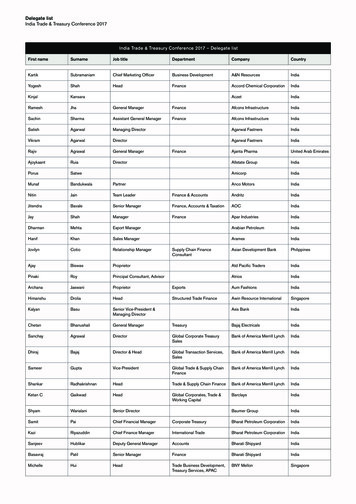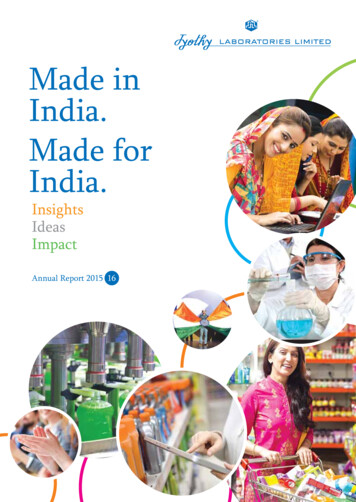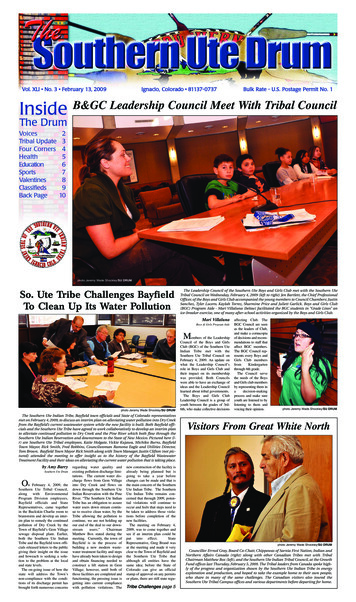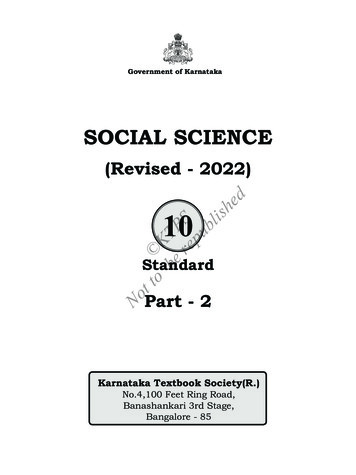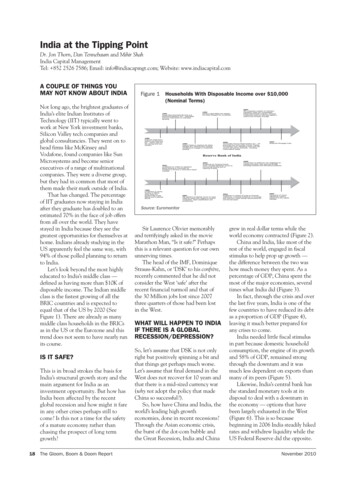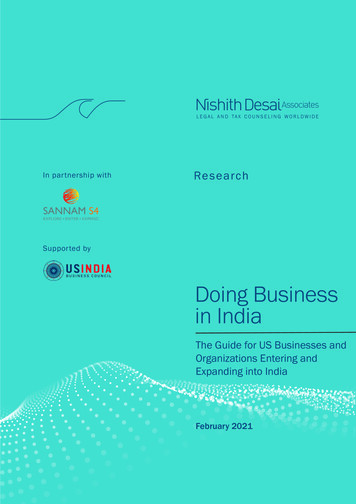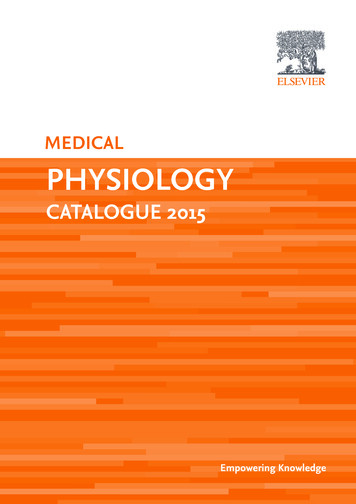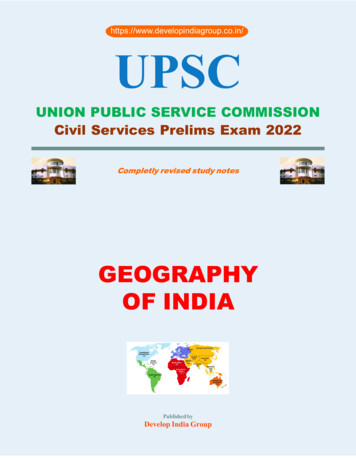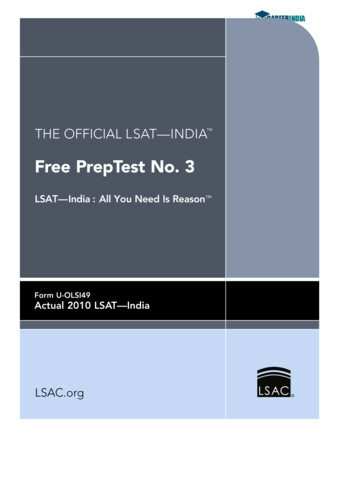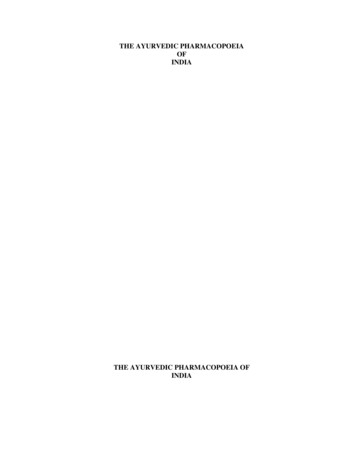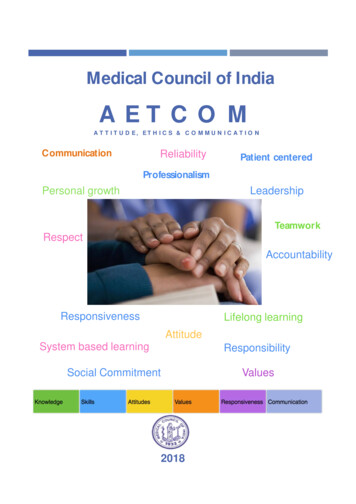
Transcription
Medical Council of IndiaAETCOMATTITUDE, ETHICS & COMMUNICATIONCommunicationReliabilityPatient centeredProfessionalismPersonal nsivenessLifelong learningAttitudeSystem based learningResponsibilitySocial CommitmentValues2018
Attitude, Ethics and Communication(AETCOM)Competencies for theIndian Medical Graduate2018Medical Council of IndiaPocket-14, Sector-8, Dwarka,New Delhi 110 077
FOREWORDMedical education has its deep rooted relevance with reference to creationof trained health manpower in the country capable of shouldering the onusand responsibility ensuring an effective health care delivery system. It isthe prime concern upper most in the minds of all concerned as to whetherthe said dispensation is mitigated adequately or otherwise? Attainment onthis count in my opinion is a ‘minimum must’ and therefore all ‘initiatives’with concrete cause are warranted towards realistic and meaningfulactualization of the same.The crystallization of objectives ensuring corresponding curriculum withappropriate teaching learning strategies, tools, techniques and technologyand commensurate mode of assessment are the parts of the core model forproviding quality based undergraduate medical education.It gives me great satisfaction that the ‘competency based curriculum’ thathas been proposed by the Medical Council of India would definitely serve alarger cause in the domain of ‘quality centricity’.The “Conative domain” which hitherto was not appropriately incorporatedand structured in the curriculum has been specifically dispensed of byproviding a definitive model for the same titled AETCOM “Attitude, Ethicsand Communication Model”.Structuring them into competencies, placing them appropriately in thecurriculum design ensuring its incorporation through desired teaching andlearning would definitely ensure enrichment of the learner with desiredcommunicative and
- 2-altruistic skills with proper orientation pertaining to ethics, professionalism,leadership skills and also the attribute that shall inculcate in him/her theessence of lifelong learning.This definitely would go a long way in creating an ‘Indian MedicalGraduate’ to realistically turn out to be an ‘International Medical Graduate’capable of catering to the cause and requirement of health care deliveryacross the boundaries all over the Globe.I record my appreciation for Dr. Ved Prakash Mishra, Chairman, AcademicCommittee and his team for venturing into the said much desired exerciseand giving it the required shape out of committed painstaking labour. I amsure that this is going to change the ‘shape’ and ‘face’ of undergraduatemedical education to make it timely relevant, purposive, need based,consequential and impactful.(Dr. Jayshree Mehta)
Dr. Vedprakash MishraChairmanAcademic CommitteeMedical Council of IndiaDate : 15.09.2017FOREWORDHealth Professions and practice is a complex interplay of Knowledge, Clinical Skills &Acumen, Communication, Attitude, Inter- Professional behavior and is largelydependent on strong Ethical values. India, as one of the major stakeholders towardscontribution of world's health care, offers a major share of health professionals acrossthe globe. Hence; more so than ever; it needs a curriculum which is better alignedwith Health professional attributes that are locally relevant and globally adaptive. Thisrealization; though has struck every health professional of our country; the efforts toeffectively deal with the issue was sparsely articulated in its entirety. Teaching andlearning of medical ethics, behavioral science, communication skills, and managerialskills have not received due attention in the existing medical curriculum. The proposedAETCOM module is a manifestation of this realization that endeavors to strike abalance between the five identified roles of an ‘Indian Medical Graduate (IMG)’ viz;Clinician, Leader & Member of health care team, Communicator, Life- long learnerand Professional; right from the 1st professional year of training.The entire concept of AETCOM module lies on the fundamental principle thatchanging a person's attitude can change his or her behavior. The Cognitivecomponents of attitudes are more fundamental and constant over time and moreclosely connected to basic values. Behavioural attitudes are manifestations ofunderlying cognitive and affective attitudes. Ethical dimensions play a crucial role inbehavioral evolution and the basic building block of good communication is thefeeling that every human being is unique and of value.There are many new key areas recommended in the AETCOM module that areidentified for implementation across the entire duration of the course. It is hoped that
the successful implementation of the AETCOM modules will be forerunner of thetransition to competency based undergraduate medical education programenvisaged by the Medical Council of India. This booklet and other electronicresources provide background concept, session guidelines and other resources forthese sessions that will be useful for all faculty involved in conducting these sessions.These are conceptual frameworks only and Institutions and faculty are at liberty tomake modifications while implementing the same at their own settings.It is genuinely expected that this module plays a vital role in providing a coherentpicture of how Attitude, Communication and Bioethics can be integrated withinmedical curriculum and also inspire medical teachers to make it more meaningfuland consequential. The effort is surely a new vista to Medical education making itmore comprehensive and relevant to health needs of the society.(Dr. Vedprakash Mishra)Chancellor, Krishna Institute of Medical Sciences (Deemed University), KaradChairman, National Medical Education Board, IMA Headquarters, New DelhiPro-Chancellor, Datta Meghe Institute of Medical Sciences (Deemed University), NagpurHonorary Director, Centre for Health Sciences Education Policy and Planning, DMIMS(DU), Nagpur-2-
DR. (MRS.) REENA NAYYARHkkjrh; vk;qÆoKku ifj“knSECRETARY I/CikWdsV & 14] lsDVj & 8]}kjdk Qsl& 1uà fnYyh&110 077MEDICAL COUNCIL OF INDIAPocket- 14, Sector- 8,Dwarka Phase - 1New Delhi-110077nwjHkk“k : 25365075Phone :25365075QSDl: 0091-11-25367014Fax: 0091-11-25367014E-mail : secy-mci@nic.inWebsite : www.mciindia.orgFOREWORDMedical education today has recognized the need to teach and evaluateprofessionalism as a formal concept due to increasing concerns about physicians’conflict of interest with patients and relatives and possible loss of licensure. Theneed of the hour is to train medical professionals in this important area of clinicalpractice but is often ignored. The diagnostic capability of a doctor is greatlyenhanced if the doctor is able to effectively communicate with the patient andhis/her relatives decreasing frustration of the doctor and patient or relatives. It hasbeen aptly stated that “Medicine is an art whose magic and creative ability havelong been recognized as residing in the interpersonal aspects of patient-physicianrelationship” (Hall, Roter & Rand, 1981).Having recognized the pivotal role of effective interpersonal communicationbetween doctor and patient in clinical training and practice, the Medical Council ofIndia has embarked on an ambitious and robust Faculty Development Programme inwhich medical college teachers are trained to acquire theoretical and practical skillsin teaching. The Council has also revised and remodeled the Graduate MedicalEducation Regulations, 1997 with emphasis on curricular reforms. Teachingcurricula in various disciplines would be based on a competency based format withemphasis on domains of attitude, ethics and communication, as envisaged in theAETCOM (Attitude, Ethics and Communication) module.The AETCOM (Attitude, Ethics and Communication) module was prepared by theAcademic Cell of the Council under the inspiring leadership of Dr. Ved PrakashMishra, Chairman, Academic Committee and ably supported by Dr. M. Rajalakshmi,Academic Cell and the members of the Reconciliation Board headed by Dr. AvinashSupe to guide medical institutions and faculty to acquire the much neededcompetencies in the attitude, ethics and communication domains. I am extremelygrateful to all of them for their painstaking efforts in giving shape to such a wellstructured document and congratulate them for the same. I am sure effectiveimplementation of the revised Graduate Medical Education Regulations would go along way in improving the standards of medical education in the country.Dr. Reena Nayyar
Attitude, Ethics &Communication (AETCOM)competencies
CONTENTSPreface1Contributors3Preamble /concept7How to use this document8Definitions9Explanation of terms10Teaching Learning Methods recommended13Section I:Goals, roles and competencies of anIndian Medical Graduate: Extract fromGraduate Medical Education Regulations, 2017Section II: Learning Modules1523: Learning modules for Professional year I25: Learning modules for Professional year II39: Learning modules for Professional year III57: Learning modules for Professional year IV69Section III: Competency acquisition93Section IV: Formative elements to be marked by tutor97Appendix 1: List of AETCOM competencies approved bythe Academic Committee, MCIAppendix 2: Communication skills rating tool101107
AETCOM competencies for IMGPREFACEThe Medical Council of India has prepared revised Graduate Medical EducationRegulations 2017 and competency based UG curricula, accompanied by guidance for itsimplementation. In response to this, every medical college needs to develop the capacity toadapt to the requirements of the new guidelines. Earlier experience with implementation ofcurricular changes suggests that a carefully managed, sustainable approach is necessary toensure that every college has access to these new skills and knowledge. Faculty developmenthas been seen to play a key role in the implementation and sustenance of any curricularreforms.The Medical Council of India has decided to implement Attitude, Ethics andCommunication module (AETCOM) in all medical schools across the country over the nexttwo years. It is against this backdrop that the AETCOM module is prepared along withfacilitators guide. This activity has been supported wholeheartedly by the President ofMedical Council of India, Dr. Jayshree Mehta and under the inspiring guidance of Dr. VedPrakash Mishra, Chairman, Academic Committee and whole hearted support of Dr. ReenaNayyar, Secretary-in-charge, Medical Council of India. There are many new key areasrecommended in the AETCOM module that were identified for implementation across theentire duration of the course. It is hoped that the successful implementation of the AETCOMmodule would be the forerunner of the transition to competency based undergraduatemedical education program envisaged by the Medical Council of India.This booklet and other electronic resources provide background concept, sessionguidelines and other resources for these sessions. These will be useful for all facultyinvolved in conducting these sessions. These are conceptual frameworks only andinstitutions and faculty are at liberty to make modifications while implementing the same attheir own settings.It is proposed that the existing network of MCI Nodal and Regional Centers andMedical Education Units of all medical colleges will be the torchbearers of thistransformational change. We hope that such a change will significantly impact the quality ofcommunity health and patient care in our country.1
AETCOM competencies for IMG1.ContributorsDr. Avinash SupeDirector (ME & MH) and Dean, Professor,Departments of G I Surgery and Medical EducationSeth GSMC and KEM Hospital, Mumbai – 4000122.Dr. Krishna G. SeshadriMember, Board of ManagementVisiting ProfessorDepartments of Endocrinology, Diabetes and Medical EducationSri Balaji Vidyapeeth, Puducherry - 607 4033.Dr. Tejinder SinghProfessor, Departments of Pediatrics and Medical EducationConvenor, MCI Nodal Centre for Faculty DevelopmentChristian Medical College, Ludhiana, Punjab - 1410084.Dr. R. Sajith KumarProfessor and Head, Departments of Infectious Disease and Medical EducationConvenor, MCI Nodal Centre for Faculty DevelopmentGovernment Medical College, Kottayam, Kerala - 6860085.Dr. Praveen SinghProfessor and Head, Departments of Anatomy and Medical EducationConvenor, MCI Nodal Centre for Faculty DevelopmentPramukhswami Medical College, Karamsad, Gujarat - 3883256.Dr. P.V. ChalamPrincipal, Professor, Department of SurgeryBhaskar Medical College, RR Dist.,Telangana - 5000757.Dr. Subir K. MaulikProfessor, Department of PharmacologyAll India Institute of Medical Sciences, New Delhi-1100298.Dr. Sanjiv LewinProfessor & Head, Departments of Pediatrics & Medical EducationSt. John’s Medical College, Bangalore-5600349.Dr. Himanshu PandyaProfessor and Head, Department of MedicineProfessor, Department of Medical EducationPramukhswami Medical College, Karamsad, Gujarat - 38832510. Dr. M. RajalakshmiChief ConsultantAcademic Cell, Medical Council of IndiaNew Dehi-1100772
AETCOM competencies for IMGAttitude, Ethics and Communication (AETCOM) Competenciesfor theIndian Medical GraduatePreamble/ConceptThe overall goal of undergraduate medical education program as envisaged in therevised Graduate Medical Education Regulations - 2017 is to create an “Indian MedicalGraduate” (IMG) possessing requisite knowledge, skills, attitudes, values andresponsiveness, so that she or he may function appropriately and effectively as a physicianof first contact of the community while being globally relevant. In order to fulfill this goal,the IMG must be able to function appropriately, ethically and effectively in her/his roles asclinician, leader and member of the health care team and system, communicator, lifelonglearner and as a professional. In order to effectively fulfill the above mentioned roles, theIMG must obtain a set of competencies at the time of graduation. In order to ensure thattraining is in alignment with the goals and competencies, Medical Council of India hasproposed new teaching learning approaches including a structured longitudinal programmeon attitude, ethics and communication.Role modelling and mentoring associated with classical approach to professionalapprenticeship has long been a powerful tool. This approach alone is no longer sufficientfor the development of a medical professional. The domains of attitude andcommunications with emphasis on ethics therefore need to be taught directly and explicitlythroughout the undergraduate curriculum. The two major aspects of teachingprofessionalism include explicit teaching of cognitive base and stage appropriateopportunities for experiential learning and reflection throughout the curriculum.AETCOM module has been prepared as a guide to facilitate institutions and facultyin implementing a longitudinal program that will help students acquire necessarycompetence in the attitudinal, ethical and communication domains. It offers framework ofcompetencies that students must achieve. It also offers approaches to teaching learningmethods. However, it is a suggested format and institutions can develop their ownapproaches to impart these competencies.3
AETCOM competencies for IMGHow to use this documentThis document is a guide to facilitate institutions and faculty in implementing alongitudinal program that will help students acquire necessary competence in the attitude,ethics and communication domains. The purpose of this program is to allow the graduateto function in roles envisaged in the revised Graduate Medical Education Regulations,2017 (GMR 2017). The revised GMR 2017 document creates roles for the graduate thatgoes beyond the traditional knowledge and skill components. In particular, it adds fourroles – leader and member of the health care team, communicator, life-long learner andprofessional - which call for learning and skills not addressed by the traditional syllabi.The document is divided into the following:1.Section I: contains an extract of the goals, roles and universal competencies as envisagedin the GMR 2017 document. This is the base document upon which all learning in theundergraduate years must be based and lists the final competencies that all students mustachieve.2.Section II: contains suggested teaching modules for each professional year includingresources cases and methods to teach.3.Section III: contains a list of additional non-core competencies that form a desirable setof learning.4.Section IV: is a competency log that contains a list of skills that may be acquired prior tograduation. These skills are best imparted in a simulated setting (usually involvingstandardized patients). They are also best done progressing in complexity over time. Forexample, a skill on communicating treatment options may be acquired at different levelsof complexities spread over phases before finally being certified.5.Section V: contains formative elements that are observable by tutors/mentors/guides andmarked over time with appropriate feedback in a non-punitive fashion.6.Appendix 1: consists of the entire set of competencies as approved by the AcademicCommittee of the Medical Council of India.7.Appendix 2: provides a modified communication skill rating tool adapted from theKalamazoo consensus.4
AETCOM competencies for IMGDefinitions1. Goal: A projected state of affairs that a person or system plans to achieve.In other words: Where do you want to go? or What do you want to become?2. Competency: The habitual and judicious use of communication, knowledge, technical skills,clinical reasoning, emotions, values, and reflection in daily practice for the benefit of theindividual and community being served.In other words: What should you have? or What should have changed?3. Objective: Statement of what a learner should be able to do at the end of a specific learningexperience.In other words: What the Indian Medical Graduate should know, do, or behave.Action Verbs used in this rm under supervisionDemonstrate understanding ofDiscussPerform cified essential competencies only will be required to be performed independently at the end of thefinal year MBBS.The word ‘perform’ or ‘do’ is used ONLY if the task has to be done on patients or in laboratorypracticals in the pre/para- clinical phases.3.Most tasks that require performance during undergraduate years will be performed under supervision.4.If a certification to perform independently has been done, then the number of times the task has to beperformed under supervision will be indicated in the last column.5
AETCOM competencies for IMGExplanation of terms used in this documentLectureAny instructional large group method including traditionallecture and interactive lectureSmall group discussionAny instructional method involving small groups of studentsin an appropriate learning contextDOAP (Demonstration-A practical session that allows the student to observe aObservation - Assistancedemonstration, assist the performer, perform in a simulated- Performance)environment, perform under supervision or performindependentlySkill assessmentA session that assesses the skill of the student including thosein the practical laboratory, skills lab, skills station that usesmannequins/ paper case/simulated patients/real patients asthe context demandsCoreA competency that is necessary in order to complete therequirements of the subject (traditional must know)Non-CoreA competency that is optional in order to complete therequirements of the subject (traditional nice (good) to know/desirable to know)National GuidelinesHealth programs as relevant to the competency that are partof the National Health ProgramDomains of learningKKnowledgeSSkillAAttitudeCCommunication6
AETCOM competencies for IMGLevels of competencyKKnowsA knowledge attribute - Usually enumerates or describesKHKnows howA higher level of knowledge - is able to discuss or analyseSShowsA skill attribute: is able to identify or demonstrate the stepsSHShows howA skill attribute: is able to interpret/ demonstrate a complexprocedure requiring thought, knowledge and behaviorPPerformsMastery for the level of competence - When done(underindependently under supervision a pre-specified number ofsupervision ortimes - certification or capacity to perform independentlyindependently)resultsNote:In the table of competency - the highest level of competency acquired is specified and implies that thelower levels have been acquired already. Therefore, when a student is able to SH - Show how - aninformed consent is obtained - it is presumed that the preceding steps - the knowledge, the analytical skills,the skill of communicating have all been obtained.It may also be noted that attainment of the highest level of competency may be obtained through stepsspread over several subjects or phases and not necessarily in the subject or the phase in which thecompetency has been identified.7
AETCOM competencies for IMGTeaching Learning Methods recommendedGuidelines for Case DiscussionA hybrid problem-oriented approach is one of the most effective ways for students toexplore the various facets of “real life issues” that will confront them in their careers. Inaddition to problem solving skills, case discussions promote collaborative learning, teamwork, reflection and self-directed learning. The cases presented in this booklet representcompetencies that lend themselves best to this form of learning.The figure on the following page explains the suggested format of the hybrid problem-basedlearning method:1.Two or more learning sessions are recommended for each session with ample timefor self-directed learning and other learning activities between each session.2.A case is introduced into a small group and the facilitator facilitates a small groupdiscussion where,a. initial reactions of the group to the case is obtainedb. the underlying ethical, legal and societal principles of the case are elicitedc. learning objectives for the case are developedd. learning tasks are assigned for members of the learning groupse. learning resources are identifiedo The suggested location for such a session is a small group discussionarea which requires a small table with seating for 8 - 10 studentso Suggested duration for such a session is 1 houro A board with chalk or marker is also required3.Learning occurs in between sessions by the learners through following:o Self-directed learning by study of identified learning resourceso Self-directed learning through study of online learning resourceso Identification of legal, ethical and social precedents for the given settingso Obtaining opinion from seniors in the profession on their impressions on thesetting4.Reinforcement of the fundamental concepts underlying the case can be done througha large group learning session (lecture or equivalent) in between the smallgroup sessions.8
AETCOM competencies for IMG5.In the second session, the small group discussion is focussed on closure of the case(or the part of the case) for which learning objectives were identified for in the firstsession. The facilitators may guide the discussion based on the ethical, legal, societaland communication aspects of the case. The group discusses the case, based on thelearning done in between the session and provides suggestions and alternatives onthe approach for doctors to follow. It must be reiterated that there may not be onecorrect way to resolve a case. The approach will be to allow students to reflect, makea choice and defend their choice, based on their values and learning.Student narrativeThe student narrative is a learning method that focuses on the following skills:a. Elicit, observe and record data.b. Reflect on the data at a higher level of thinking and derive opinions andconclusions.c. Communicate the observations and conclusions in a written and verbal formand expand on and defend the conclusions with colleagues and teachers.d. Form new experiences and conclusions based on this discussion.9
AETCOM competencies for IMGSection I10
AETCOM competencies for IMGExtract from the Graduate Medical EducationRegulations, 20171.The undergraduate medical education program is designed with a goal to create an“Indian Medical Graduate” (IMG) possessing requisite knowledge, skills, attitudes,values and responsiveness, so that he or she may function appropriately andeffectively as a doctor of first contact of the community while being globally relevant.2.In order to fulfill this goal, the IMG must be able to function in the following ROLESappropriately and effectively:2.1. Clinician who understands and provides preventive, promotive, curative,palliative and holistic care with compassion.2.2. Leader and member of the health care team and system with capabilities tocollect, analyze, synthesize and communicate health data appropriately.2.3. Communicator with patients, families, colleagues and community.2.4. Lifelong learner committed to continuous improvement of skills andknowledge.2.5. Professional, who is committed to excellence, is ethical, responsive andaccountable to patients, community and profession.Global Attitude, Ethics and Communication Competencies addressed in the roles of anIndian Medical Graduate3. Competencies: Competency based learning would include designing and implementingmedical education curriculum that focuses on the desired and observable ability in real lifesituations. In order to effectively fulfill the roles as listed in item 2 above, the Indian MedicalGraduate would have obtained the following set of competencies at the time of graduation:3.1.Clinician, who understands and provides preventive, promotive, curative, palliativeand holistic care with compassion3.1.1. Demonstrate knowledge of normal human structure, function and developmentfrom a molecular, cellular, biologic, clinical, behavioral and social perspective.3.1.2. Demonstrate knowledge of abnormal human structure, function and developmentfrom a molecular, cellular, biological, clinical, behavioural and social perspective.3.1.3. Demonstrate knowledge of medico-legal, societal, ethical and humanitarian11
AETCOM competencies for IMGprinciples that influence health care.3.1.4. Demonstrate knowledge of national and regional health care policies including theNational Health Mission (NHM), frameworks, economics and systems thatinfluence health promotion, health care delivery, disease prevention, effectiveness,responsiveness, quality and patient safety.3.1.5. Demonstrate ability to elicit and record from the patient, and other relevant sourcesincluding relatives and caregivers, a history that is complete and relevant to diseaseidentification, disease prevention and health promotion.3.1.6. Demonstrate ability to elicit and record from the patient, and other relevant sourcesincluding relatives and caregivers, a history that is contextual to gender, age,vulnerability, social and economic status, patient preferences, beliefs and values.3.1.7. Demonstrate ability to perform a physical examination that is complete andrelevant to disease identification, disease prevention and health promotion.3.1.8. Demonstrate ability to perform a physical examination that is contextual to gender,social and economic status, patient preferences and values.3.1.9. Demonstrate effective clinical problem solving, judgment and ability to interpretand integrate available data in order to address patient problems, generatedifferential diagnoses and develop individualized management plans that includepreventive, promotive and therapeutic goals.3.1.10. Maintain accurate, clear and appropriate records of the patient in conformationwith legal and administrative frameworks.3.1.11. Demonstrate ability to choose the appropriate diagnostic tests and interpret thesetests based on scientific validity, cost effectiveness and clinical context.3.1.12. Demonstrate ability to prescribe and safely administer appropriate therapiesincluding nutritional interventions, pharmacotherapy and interventions based onthe principles of rational drug therapy, scientific validity, evidence and cost thatconform to established national and regional health programs and policies for thefollowing:a.Disease prevention,b.Health promotion and cure,c.Pain and distress alleviation, andd.Rehabilitation and palliation.12
AETCOM competencies for IMG3.1.13 Demonstrate ability to provide a continuum of care at the primary and/or secondarylevel that addresses chronicity, mental and physical disability.3.1.14 Demonstrate ability to appropriately identify and refer patients who may requirespecialized or advanced tertiary care.3.1.15 Demonstrate familiarity with basic, clinical and translational research as it appliesto the care of the patient.3.2.Leader and member of the health care team and system3.2.1 Work effectively and appropriately with colleagues in an inter-professional healthcare team respecting diversity of roles, responsibilities and competencies of otherprofessionals.3.2.2 Recognize and function effectively, responsibly and appropriately as a health careteam leader in primary and secondary health care settings.3.2.3 Educate and motivate other members of the team and work in a collaborative andcollegial fashion that will help maximize the health care delivery potential of theteam.3.2.4 Access and utilize components of the health care system and health delivery in amanner that is appropriate, cost effective, fair and in compliance with the nationalhealth care priorities and policies, as well as be able to collect, analyze and utilizehealth data.3.2.5 Participate appropriately and effectively in measures that will advance quality ofhealth care and patient safety within the health care system3.2.6 Recognise and advo
Medical Council of India 2018. Attitude, Ethics and Communication (AETCOM) Competencies for the Indian Medical Graduate 2018 Medical Council of India Pocket-14, Sector-8, Dwarka, New Delhi 110 077 . F O
